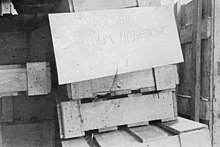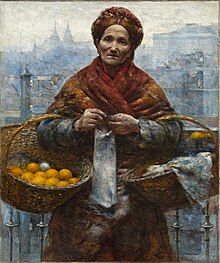The looting of Polish cultural artifacts and industrial infrastructure during World War II was carried out by Nazi Germany and the Soviet Union simultaneously after the invasion of Poland of 1939. A significant portion of Poland's cultural heritage, estimated at half a million art objects, was plundered by the occupying powers. Catalogued pieces are still occasionally recovered elsewhere in the world and returned to Poland.
Priceless items of art still considered missing or found in other museums include works by Bernardo Bellotto, Anna Bilińska-Bohdanowicz, Józef Brandt, Lucas Cranach the Elder, Lucas Cranach the Younger, Albrecht Dürer, Anthony van Dyck, Hans Holbein the Younger, Jacob Jordaens, Frans Luycx, Jacek Malczewski, Raphael, Rembrandt van Rijn, Peter Paul Rubens, Henryk Siemiradzki, Veit Stoss, Alfred Wierusz-Kowalski, Leon Wyczółkowski, Jan Matejko, Henri Gervex, Ludwig Buchhorn, Józef Simmler, Henri-Pierre Danloux, Jan Miense Molenaer and many others.[1]
As part of its efforts to locate and retrieve the missing items of art, the Ministry of Culture and National Heritage established a Database of War Losses. As of 2013 it contained over 63,000 entries.[2] The list, published by the Ministry is submitted to the National Institute of Museology and Collections Protection, to Polish embassies, and the Central Registry of Information on Looted Cultural Property 1933-1945 (lootedart.com). It is periodically sent to over 100 auction houses around the world.[2] In addition, the Ministry has also established The Lost Museum website, a virtual museum containing historical photographs of the many art objects still missing.[2][3]
- ^ Agnieszka Sural (2013). "Najcenniejsze dzieła zaginione podczas II wojny światowej" [The most precious pieces of art missing since WWII]. Culture.pl (in Polish) (2013–08–13). Warsaw: Adam Mickiewicz Institute. Retrieved 2013-08-22.
- ^ a b c Muzeum Utracone (2013). "About The Lost Museum". muzeumutracone.pl. Muzeum Utracone. Retrieved 2013-08-22.
- ^ Cite error: The named reference
gpwas invoked but never defined (see the help page).



